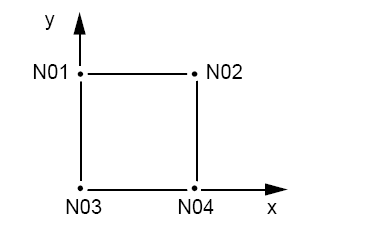13. L modeling#
13.1. Characteristics of modeling#
C_ PLAN plane stress modeling similar to B modeling except that we replace the VMIS_ISOT_LINE law by VMIS_ISOT_NL (reduced to the case of linear work hardening), which triggers the DEBORST algorithm to treat plane stresses.

Loading and boundary conditions are modelled by:
Dirichlet condition (keyword DDL_IMPO):
Node \(\mathit{N04}\), \(x\mathrm{=}y\mathrm{=}0\),
Node \(\mathit{N02}\), \(x\mathrm{=}0\).
Neumann condition, surface forces (keyword FORCE_CONTOUR):
on the faces (skin elements): (1, 2), (2, 4), (4, 3) and (3, 1).
13.2. Characteristics of the mesh#
Number of knots: 4
Number of meshes and types: 1 QUAD4, 4 SEG2
13.3. Tested sizes and results#
Identification |
Instants |
Reference |
% Tolerance |
\({\sigma }_{\mathrm{xx}}\) |
|
151.2 |
0.1 |
\({\sigma }_{\mathrm{xy}}\) |
|
93.1 |
0.1 |
\({\varepsilon }_{\mathrm{xx}}\) |
|
1.4830 10—2 |
0.1 |
\({\varepsilon }_{\mathrm{xy}}\) |
|
1.3601 10—2 |
0.1 |
\(p\) |
|
2.055 10—2 |
0.1 |
Triaxiality rate \(\mathit{TRIAX}\) |
|
2.28 10—1 |
0.1 |
\({\epsilon }_{\mathit{xx}}\) |
|
3.5265 10—2 |
1.0 |
\({\epsilon }_{\mathit{xy}}\) |
|
2.0471 10—2 |
1.0 |
\(p\) |
|
4.2329 10—2 |
1.0 |
Triaxiality rate \(\mathit{TRIAX}\) |
|
3.25349 10—1 |
0.1 |
\({\epsilon }_{\mathit{xx}}^{p}\) |
|
3.3946 10—2 |
1.0 |
\({\epsilon }_{\mathit{xy}}^{p}\) |
|
2.0250 10—2 |
1.0 |